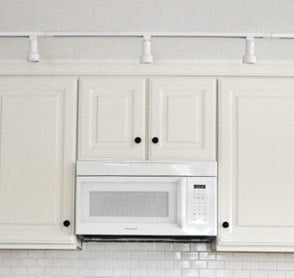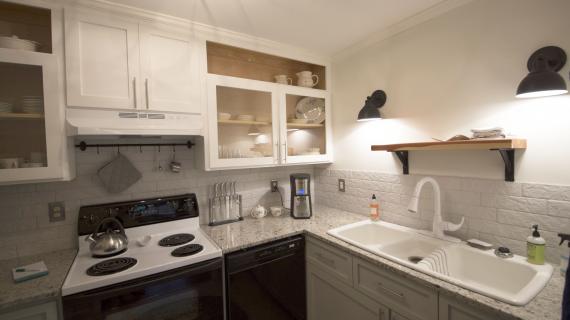
Standard 30" wide x 12" tall over the range wall cabinet, designed for over a microhood or vent. Free kitchen cabinet plans from Ana-White.com

Preparation
8 feet of 1x2s for face frame
3/4" plywood ripped into strips 10-1/4" wide
1x4 or plywood scrap for the back support
1/4" plywood for back
1-1/4" pocket hole screws
3/4" finish nails for attaching back
edge banding for finishing shelf fronts
shelf pins for adding shelves
DOOR and 1-1/4" overlay concealed hinges for FACE FRAMES
2 - 3/4" plywood @ 10-1/4" x 12" (Sides)
2 - 3/4" plywood @ 10-1/4" x 28" (Top/Bottom)
1 - 3/4" plwyood OR 1x4 @ 28" (Back Top Support)
1 - 1/4" plywood @ 29-1/2" x 12" (Back)
2 - 1x2 @ 12" (Face Frame stiles)
2 - 1x2 @ 27" (Face Frame rails)
1 - 1x3 @ 9" (Face Frame mid stile)
FULL OVERLAY DOORS (2) SIZE 11" x 14-1/2"
Please read through the entire plan and all comments before beginning this project. It is also advisable to review the Getting Started Section. Take all necessary precautions to build safely and smartly. Work on a clean level surface, free of imperfections or debris. Always use straight boards. Check for square after each step. Always predrill holes before attaching with screws. Use glue with finish nails for a stronger hold. Wipe excess glue off bare wood for stained projects, as dried glue will not take stain. Be safe, have fun, and ask for help if you need it. Good luck!
Instructions
Step 1
On the outsides of the sides and top/bottom, drill 3/4" pocket holes along the front edges (outsides or less attractive side) of the pieces, for attaching the face frame in later steps. These pocket holes will be covered by neighboring cabinets, or if end cabinet, covered in 1/4" finished plywood to match doors and face frames.
Then on the outsides, drill 3/4" pocket holes on each end of the top and bottom, and attach to sides with 1-1/4" pocket hole screws and glue.
Step 2
Step 3
Step 4
It is always recommended to apply a test coat on a hidden area or scrap piece to ensure color evenness and adhesion. Use primer or wood conditioner as needed.





















Comments
DecorSanity
Wed, 01/08/2014 - 06:00
I don't know how you do it!
You must be exhausted with a new baby, but you are a do-er and cannot be stopped! Did you find infant sized noise-reducing earmuffs and sawdust shield yet? :-)
Lady Goats
Wed, 01/08/2014 - 12:29
So exciting!
Glad to hear you got it al worked out (I'd be so dismayed to chop 8" off of a finished cabinet!). As I've said before, this kitchen is a stunner! So thanks for sharing all the plans!